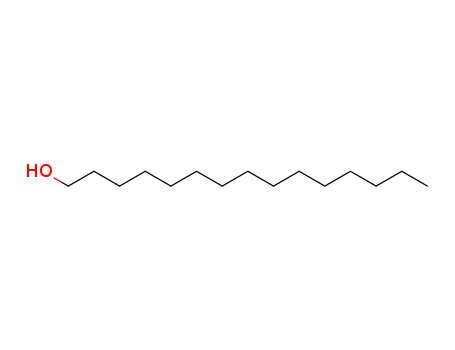- Chemical Name:1-Pentadecanol
- CAS No.:629-76-5
- Deprecated CAS:39387-31-0,39433-03-9,39457-30-2,60650-33-1,63393-83-9
- Molecular Formula:C15H32O
- Molecular Weight:228.418
- Hs Code.:
- European Community (EC) Number:211-107-9
- NSC Number:66446
- UNII:333QVA4G2Q
- DSSTox Substance ID:DTXSID0027270
- Nikkaji Number:J45.981J
- Wikipedia:1-Pentadecanol
- Wikidata:Q27146999
- Metabolomics Workbench ID:3284
- ChEMBL ID:CHEMBL26561
- Mol file:629-76-5.mol
Synonyms:1-PENTADECANOL;pentadecan-1-ol;629-76-5;Pentadecyl alcohol;Pentadecanol;n-Pentadecanol;n-1-Pentadecanol;Neodol 5;Alfol 15;MFCD00004759;31389-11-4;UNII-333QVA4G2Q;333QVA4G2Q;67762-25-8;DTXSID0027270;CHEBI:77468;C15H32O;EINECS 211-107-9;NSC 66446;NSC-66446;AI3-33881;n-pentadecyl alcohol;DTXCID207270;CAS-629-76-5;n-pPentadecanol;Pentadecanol-(1);Pentadecan- 1- ol;Pentadecanol (6CI);PDC (CHRIS Code);1-Pentadecanol, 99%;SCHEMBL29548;CHEMBL26561;AMY5936;PENTADECYL ALCOHOL [INCI];1-pentadecanol (ACD/Name 4.0);NSC66446;EINECS 267-006-5;Tox21_201699;Tox21_300553;LMFA05000194;STL453722;AKOS009031435;CS-W004295;HY-W004295;Pentadecanol,95%;n-Pentadecyl alcohol;NCGC00164169-01;NCGC00164169-02;NCGC00164169-03;NCGC00254478-01;NCGC00259248-01;BP-30139;SY049687;FT-0608196;P0036;EN300-20042;H10901;A868289;Q27146999;F0001-1704;1991DA79-7140-48B0-9F03-1E3D88AC4F28





